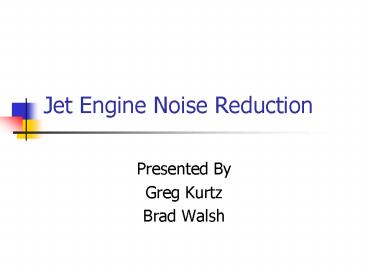Jet Engine Noise Reduction - PowerPoint PPT Presentation
1 / 30
Title:
Jet Engine Noise Reduction
Description:
Since 1976 the number of people exposed to Jet noise above 65 dB ... Choked Mixer Nozzle. Noise Reduction Nozzles Cont. Acoustically Insulated Ejector Shroud ... – PowerPoint PPT presentation
Number of Views:1907
Avg rating:3.0/5.0
Title: Jet Engine Noise Reduction
1
Jet Engine Noise Reduction
- Presented By
- Greg Kurtz
- Brad Walsh
2
Overview
- Problems Caused by excessive noise
- History of Noise control
- FAA noise regulations
- Sources of Jet engine noise
- Methods of Reducing Jet Engine noise
- Acoustic properties
3
Environmental Effects of Noise
- Some Wildlife animals are effected
- Annoyance
- Hearing Loss
- Sleep interference
- Attention Span
- Real Estate Values
4
Annoyance
5
Human Ear Range of Pressureand Frequency Response
6
Reference Decibel Levels
7
Effects of Noise Regulations
- Since 1976 the number of people exposed to Jet
noise above 65 dB has dropped from 7 million to
500,000. - Flight paths have been established away from
highly populated areas - Buildings near airports such as homes, schools
and businesses are being acoustically insulated
8
History of Jet Noise
- Commercial Jets in 1960s were 6x louder than
those of today - Lighthill and Goldstein were two biggest players
in acoustic theory developement - Low bypass-ratio jets were later replaced with
high bypass ratio jets - Low bypass-ratio jets produce higher exit
velocities
9
Current FAA Goals
- Continue to reduce aircraft noise at the source
(phase out stage 1 and 2 aircraft) - Use new technology to mitigate noise impact
- Encourage compatible use of land and discourage
incompatible usage around airports
- Look further into the design of flight paths
around highly populated areas - Provide special consideration for national parks
and reserves - Ensure strong financial support for noise control
project
10
Projection of Noise reduction
11
Noise Source Components
12
Comparing High and Low Bypass Ratio Noise
13
Jet Engine Noise Source Levels
14
Methods of Noise Reduction
- Active Control
- Active Noise Control Fan
- Jet Nozzles
- Thrust of engines and number of engines
- Lift and drag exerted on aircraft
- Angle of takeoff and decent
- Location of Engines
- Mount engines on top of wing
15
Active Control Fans
- Glenn Research Center
16
Active Control Fan performance
- Goal is to achieve a 6 dB reduction in jet
exhaust noise - Currently the fan has demonstrated a 3 dB
Reduction in fan noise
17
Noise Reduction Nozzles
18
Noise Reduction Nozzles Cont.
- Choked Mixer Nozzle
19
Noise Reduction Nozzles Cont.
- Acoustically Insulated Ejector Shroud
20
Chevron Jet Exhaust Nozzles
21
Jet Nozzle performance
- Jet nozzles typically provide a 5 to 10 dB
reduction in jet noise - This is done by mixing exhaust gases with bypass
or ambient air prior to exiting the engine. - The result of mixing is a lower exhaust gas
velocity and less turbulence with ambient air
22
Causes of Sound
- Differences in pressure and velocity with ambient
air - Obstruction to airflow such as sharp edges, bends
in flow, ect. - Turbulence from rapid fluctuations in air
velocity - Boundary layer separation giving random
distribution of frequencies and amplitude of
sound
23
Turbulence
- Noise sources that are generated by shear layers
in fluid flow are dipoles - Dipoles exist in a close stream flow
- Quadrupoles exist in a free jet boundary
- Monopoles are produced at 5x the diameter of the
jet nozzle - Monopoles sound pressure is proportional to r-1
- This means that for every doubling of distance
from the jet nozzle the pressure will be half (or
a decrease of 6db).
24
Turbulence
25
Acoustic Properties
- Speed of Sound
- Lighthills eighth-power law
- Decibel Level
- sound pressure level
26
Sound Pressure Level
- From the definition of SPL and Lighthills eighth
power rule - Nm total mass flow rate
- V is jet exhaust velocity
- r is shortest distance from microphone to flight
path
27
Takeoff and Landing Profile
28
Sound Pressure Level
29
Sound Pressure Level
30
Any Questions ?































